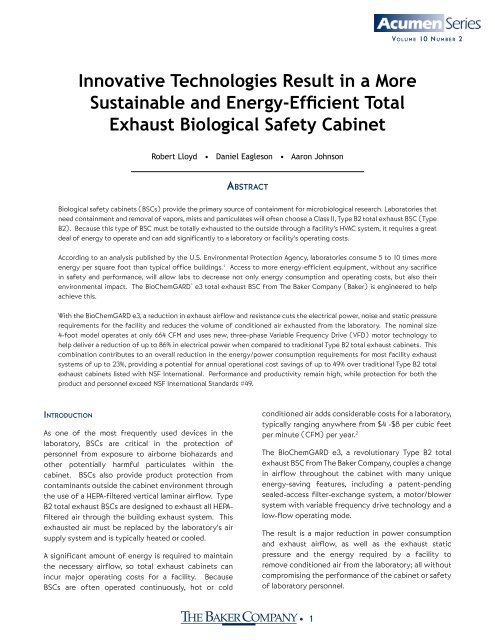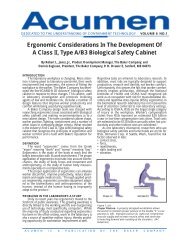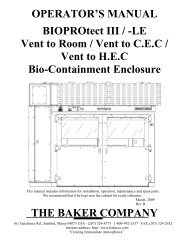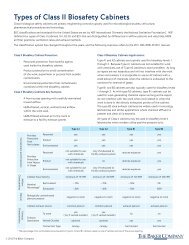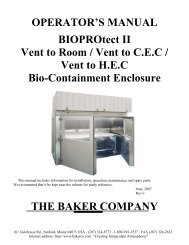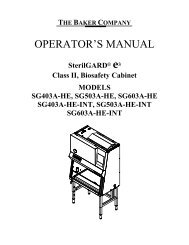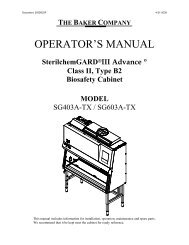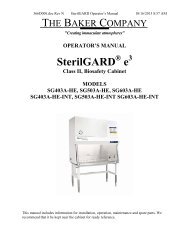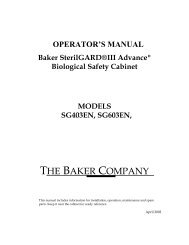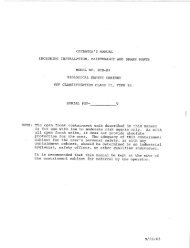Download the BioChemGARD white paper - The Baker Company Blog
Download the BioChemGARD white paper - The Baker Company Blog
Download the BioChemGARD white paper - The Baker Company Blog
You also want an ePaper? Increase the reach of your titles
YUMPU automatically turns print PDFs into web optimized ePapers that Google loves.
V o l u m e 10 Number 2<br />
Innovative Technologies Result in a More<br />
Sustainable and Energy-Efficient Total<br />
Exhaust Biological Safety Cabinet<br />
Robert Lloyd • Daniel Eagleson • Aaron Johnson<br />
Abstract<br />
Biological safety cabinets (BSCs) provide <strong>the</strong> primary source of containment for microbiological research. Laboratories that<br />
need containment and removal of vapors, mists and particulates will often choose a Class II, Type B2 total exhaust BSC (Type<br />
B2). Because this type of BSC must be totally exhausted to <strong>the</strong> outside through a facility’s HVAC system, it requires a great<br />
deal of energy to operate and can add significantly to a laboratory or facility’s operating costs.<br />
According to an analysis published by <strong>the</strong> U.S. Environmental Protection Agency, laboratories consume 5 to 10 times more<br />
energy per square foot than typical office buildings. 1 Access to more energy-efficient equipment, without any sacrifice<br />
in safety and performance, will allow labs to decrease not only energy consumption and operating costs, but also <strong>the</strong>ir<br />
environmental impact. <strong>The</strong> <strong>BioChemGARD</strong> ® e3 total exhaust BSC from <strong>The</strong> <strong>Baker</strong> <strong>Company</strong> (<strong>Baker</strong>) is engineered to help<br />
achieve this.<br />
With <strong>the</strong> <strong>BioChemGARD</strong> e3, a reduction in exhaust airflow and resistance cuts <strong>the</strong> electrical power, noise and static pressure<br />
requirements for <strong>the</strong> facility and reduces <strong>the</strong> volume of conditioned air exhausted from <strong>the</strong> laboratory. <strong>The</strong> nominal size<br />
4-foot model operates at only 664 CFM and uses new, three-phase Variable Frequency Drive (VFD) motor technology to<br />
help deliver a reduction of up to 86% in electrical power when compared to traditional Type B2 total exhaust cabinets. This<br />
combination contributes to an overall reduction in <strong>the</strong> energy/power consumption requirements for most facility exhaust<br />
systems of up to 23%, providing a potential for annual operational cost savings of up to 49% over traditional Type B2 total<br />
exhaust cabinets listed with NSF International. Performance and productivity remain high, while protection for both <strong>the</strong><br />
product and personnel exceed NSF International Standards #49.<br />
Introduction<br />
As one of <strong>the</strong> most frequently used devices in <strong>the</strong><br />
laboratory, BSCs are critical in <strong>the</strong> protection of<br />
personnel from exposure to airborne biohazards and<br />
o<strong>the</strong>r potentially harmful particulates within <strong>the</strong><br />
cabinet. BSCs also provide product protection from<br />
contaminants outside <strong>the</strong> cabinet environment through<br />
<strong>the</strong> use of a HEPA-filtered vertical laminar airflow. Type<br />
B2 total exhaust BSCs are designed to exhaust all HEPAfiltered<br />
air through <strong>the</strong> building exhaust system. This<br />
exhausted air must be replaced by <strong>the</strong> laboratory’s air<br />
supply system and is typically heated or cooled.<br />
A significant amount of energy is required to maintain<br />
<strong>the</strong> necessary airflow, so total exhaust cabinets can<br />
incur major operating costs for a facility. Because<br />
BSCs are often operated continuously, hot or cold<br />
conditioned air adds considerable costs for a laboratory,<br />
typically ranging anywhere from $4 -$8 per cubic feet<br />
per minute (CFM) per year. 2<br />
<strong>The</strong> <strong>BioChemGARD</strong> e3, a revolutionary Type B2 total<br />
exhaust BSC from <strong>The</strong> <strong>Baker</strong> <strong>Company</strong>, couples a change<br />
in airflow throughout <strong>the</strong> cabinet with many unique<br />
energy-saving features, including a patent-pending<br />
sealed-access filter-exchange system, a motor/blower<br />
system with variable frequency drive technology and a<br />
low-flow operating mode.<br />
<strong>The</strong> result is a major reduction in power consumption<br />
and exhaust airflow, as well as <strong>the</strong> exhaust static<br />
pressure and <strong>the</strong> energy required by a facility to<br />
remove conditioned air from <strong>the</strong> laboratory; all without<br />
compromising <strong>the</strong> performance of <strong>the</strong> cabinet or safety<br />
of laboratory personnel.<br />
• 1
<strong>The</strong> following <strong>paper</strong> discusses <strong>the</strong>se unique features<br />
and compares <strong>the</strong> efficiency of <strong>the</strong> nominal size 4-foot<br />
model <strong>BioChemGARD</strong> e3 to an average efficiency of<br />
traditional Type B2 total exhaust cabinets available<br />
today. (3-4)<br />
Airflow Design Enhances Sustainability,<br />
Performance and Safety<br />
Innovative Filter Placement<br />
Most Type B2 total exhaust cabinets bring room air<br />
into <strong>the</strong> cabinet through both an opening in <strong>the</strong> top<br />
of <strong>the</strong> cabinet and through an inlet grille. Air from <strong>the</strong><br />
top of <strong>the</strong> cabinet flows through an initial HEPA filter<br />
and <strong>the</strong>n downward through <strong>the</strong> work area. All of <strong>the</strong><br />
contaminated air, including <strong>the</strong> air coming through <strong>the</strong><br />
inlet grill, is <strong>the</strong>n drawn into a negative-pressure plenum<br />
and exhausted through a second HEPA filter at <strong>the</strong> top<br />
of <strong>the</strong> cabinet. A dedicated exhaust system and remote<br />
blower draw all of <strong>the</strong> filtered exhaust air out of <strong>the</strong><br />
laboratory (Figure 1).<br />
<strong>The</strong> <strong>BioChemGARD</strong> e3 takes a different approach. <strong>The</strong><br />
HEPA/ULPA filters for <strong>the</strong> exhausted air are located<br />
underneath <strong>the</strong> work surface in <strong>the</strong> drain pan area<br />
allowing <strong>the</strong> exhausted air to travel directly to <strong>the</strong><br />
building exhaust system through a duct on <strong>the</strong> back of<br />
<strong>the</strong> cabinet (Figure 2).<br />
Like o<strong>the</strong>r B2 cabinets, room air enters <strong>the</strong> front access<br />
opening of <strong>the</strong> <strong>BioChemGARD</strong> e3 at a minimum of 100<br />
FPM calculated face velocity <strong>the</strong>n enters <strong>the</strong> front work<br />
surface perforation. <strong>The</strong> cabinet supply blower draws<br />
room air in at <strong>the</strong> top rear of <strong>the</strong> cabinet and pushes<br />
it into <strong>the</strong> supply plenum and through <strong>the</strong> HEPA/ULPA<br />
supply filter. <strong>The</strong> filtered down flow air in <strong>the</strong> work area<br />
splits at <strong>the</strong> work surface. Some of <strong>the</strong> air enters <strong>the</strong><br />
rear work area perforation while most of <strong>the</strong> air enters<br />
<strong>the</strong> front work surface perforation.<br />
What makes this design unique is that <strong>the</strong> air is pulled<br />
into <strong>the</strong> drain pan area where <strong>the</strong> exhaust HEPA/ULPA<br />
filters are located; <strong>the</strong>n travels up <strong>the</strong> rear exhaust<br />
plenums, and exits <strong>the</strong> cabinet to <strong>the</strong> facility exhaust<br />
system through a 12” exhaust collar at <strong>the</strong> top of <strong>the</strong><br />
cabinet. <strong>The</strong> lower volume of air and improved plenum<br />
design lower <strong>the</strong> static pressure required to exhaust<br />
through an external building exhaust system directly<br />
connected to <strong>the</strong> top of <strong>the</strong> cabinet, reducing energy<br />
requirements.<br />
Figure 1: Traditional Type B2 Cabinet and Air Flow Design<br />
Figure 2: <strong>BioChemGARD</strong> e3 Cabinet and Air Flow Design<br />
• 2
<strong>Baker</strong> pioneered a similar design in 2005, placing <strong>the</strong><br />
filters below <strong>the</strong> work surface in <strong>the</strong> NCB-D Type B1<br />
cabinet. After proving performance in <strong>the</strong> field, this<br />
was adapted and incorporated within <strong>the</strong> design for this<br />
new Type B2 cabinet, <strong>the</strong> <strong>BioChemGARD</strong> e3 (Figure 3).<br />
Research performed by <strong>Baker</strong> shows that by increasing<br />
<strong>the</strong> speed of this air curtain, one may in turn decrease<br />
<strong>the</strong> speed of <strong>the</strong> downflow air in <strong>the</strong> work space<br />
and actually achieve better results for product and<br />
personnel protection. Microbiological testing yielded<br />
better results for product and personnel protection at<br />
lower levels of downflow air velocity. 5 <strong>The</strong> momentum<br />
air curtain of <strong>the</strong> <strong>BioChemGARD</strong> e3 was modified to<br />
take advantage of this.<br />
Reducing <strong>the</strong> rate of downflow air reduces <strong>the</strong> energy<br />
consumption of <strong>the</strong> cabinet and significantly reduces<br />
<strong>the</strong> overall energy required by a laboratory or facility to<br />
condition a room and exhaust <strong>the</strong> air from <strong>the</strong> cabinet.<br />
Innovative Technology Provides Energy Savings<br />
While Increasing Productivity and Performance<br />
StediFLOW VFD Motor Technology<br />
Figure 3: <strong>The</strong> HEPA / ULPA filters are located below <strong>the</strong> work surface<br />
on <strong>the</strong> <strong>BioChemGARD</strong> e3.<br />
Safe, Simple Filter Exchange<br />
<strong>The</strong> filter placement also allows for <strong>the</strong> exclusive,<br />
patent pending, ExchangeSAFE Sealed Access Filter<br />
Exchange System (patent pending). Many traditional<br />
bag-in/bag-out (BIBO) filter systems, which are typically<br />
located in <strong>the</strong> upper cabinet plenums above <strong>the</strong> work<br />
area, require complex and time-consuming procedures<br />
for changing filters that can result in a higher risk of<br />
exposure to contaminants. <strong>Baker</strong>’s new ExchangeSAFE<br />
system permits filter bagging and exchanges within <strong>the</strong><br />
work area, providing improved access, a simpler process<br />
and an overall reduction in maintenance time while still<br />
minimizing exposure to contaminants by running <strong>the</strong><br />
exhaust during <strong>the</strong> filter change.<br />
<strong>The</strong> <strong>BioChemGARD</strong> e3 design incorporates <strong>the</strong> airflow<br />
management system used and proven in <strong>Baker</strong>’s<br />
core line of Type A2 biological safety cabinets (<strong>the</strong><br />
SterilGARD ® e3). It utilizes <strong>the</strong> three-phase VFD motor<br />
controller (StediFLOW) to provide constant air volume<br />
and automatically compensate for normal power line<br />
variations, air disruptions and filter loading.<br />
During testing, <strong>the</strong> <strong>BioChemGARD</strong> e3 4-foot nominal<br />
model was able to automatically handle an increase in<br />
pressure drop of up to 420% across <strong>the</strong> filter without<br />
reducing total air delivery by more than 10%. <strong>The</strong> motor<br />
itself draws only 0.6 amps – a 90% reduction from <strong>the</strong><br />
power consumption required by <strong>the</strong> previous <strong>Baker</strong> B2<br />
cabinet, <strong>the</strong> SterilChemGARD.<br />
Most total exhaust BSCs locate <strong>the</strong> exhaust filters in<br />
<strong>the</strong> top of <strong>the</strong> cabinet. <strong>The</strong> <strong>Baker</strong> design locates <strong>the</strong><br />
exhaust filters at <strong>the</strong> source of <strong>the</strong> contamination. By<br />
locating <strong>the</strong> exhaust filters below <strong>the</strong> work surface,<br />
contaminants are collected immediately after <strong>the</strong>y<br />
are generated, keeping <strong>the</strong> remainder of <strong>the</strong> cabinet<br />
uncontaminated.<br />
Enhanced Performance and Reduced Downflow Air<br />
An exclusive momentum air curtain is utilized in many<br />
<strong>Baker</strong> cabinets. Located directly behind <strong>the</strong> view screen,<br />
it creates a strong air barrier at <strong>the</strong> front of <strong>the</strong> cabinet,<br />
increasing protective capabilities for both products and<br />
personnel (Figure 4).<br />
Figure 4: Momentum air curtain offers an added measure of<br />
containment and protection.<br />
• 3
<strong>The</strong> StediFLOW VFD motor uses less energy, reduces<br />
heat output and operates more quietly. With state-of<strong>the</strong>-art<br />
three-phase motor technology, <strong>the</strong> VFD has a<br />
low failure rate, uses less conductor material to transmit<br />
electric power than equivalent single-phase or twophase<br />
systems at <strong>the</strong> same voltage and is less expensive<br />
to repair when compared to more common DC-ECM<br />
motors used by o<strong>the</strong>r BSC suppliers. <strong>The</strong> <strong>BioChemGARD</strong><br />
e3 motor controller is located in a clean zone away from<br />
contaminants, which makes maintenance safer.<br />
ReadySAFE Operating Mode<br />
<strong>The</strong> SteadiFLOW VFD also controls <strong>the</strong> ReadySAFE<br />
operating mode that preserves containment conditions<br />
when <strong>the</strong> <strong>BioChemGARD</strong> e3 is not in use. This fur<strong>the</strong>r<br />
reduces cabinet downtime, <strong>the</strong> heat emitted to <strong>the</strong> lab<br />
and <strong>the</strong> energy consumption of <strong>the</strong> cabinet itself (Table<br />
1).<br />
Since BSCs utilize motor/blower technology to manage<br />
<strong>the</strong> flow of HEPA-filtered air, airflow must be reduced in<br />
order to reduce <strong>the</strong> energy consumption. While significant<br />
energy savings may be achieved by shutting down <strong>the</strong><br />
BSC completely, this is not recommended. Complete<br />
cabinet shut-down often necessitates additional<br />
procedures for time-consuming decontamination and<br />
disinfection, resulting in long periods of cabinet down<br />
time and significantly impacting <strong>the</strong> productivity of <strong>the</strong><br />
lab.<br />
Operating<br />
Amperage (A)<br />
Power<br />
Consumption (W)<br />
Power<br />
Consumption<br />
(kWh/24 hr)<br />
Heat Generation<br />
(BTU / hr)<br />
Traditional<br />
B2 BSC A<br />
BCG BCG e3, BCG e3,<br />
e3 B ReadySAFE C Optimal D<br />
2.4 1.0 0.3 0.5<br />
280.0 115.0 35.0 61.7<br />
6.7 2.8 0.8 1.5<br />
955 392 119 212<br />
A<br />
Average of Type B2 Total Exhaust Cabinets listed on <strong>the</strong> NSF<br />
website, cited July 2011.<br />
B<br />
In a normal operating mode for 24 hours, <strong>the</strong> <strong>BioChemGARD</strong><br />
e3 reduces <strong>the</strong> electrical power consumption up to 60%<br />
when compared to traditional Type B2 BSCs.<br />
C<br />
In ReadySAFE mode only, <strong>the</strong> <strong>BioChemGARD</strong> e3 reduces<br />
<strong>the</strong> electrical power consumption by up to 90%, when<br />
compared to traditional Type B2 BSCs.<br />
D<br />
Operating in normal mode during <strong>the</strong> work day (8 hours) and<br />
ReadySAFE mode at night (16 hours), <strong>the</strong> <strong>BioChemGARD</strong> e3<br />
reduces <strong>the</strong> power consumption by up to 80%, when compared<br />
to traditional Type B2 BSCs.<br />
<strong>The</strong> <strong>Baker</strong> ReadySAFE mode provides a reduced flow<br />
operating mode for <strong>the</strong> <strong>BioChemGARD</strong> e3. <strong>The</strong> speed<br />
of <strong>the</strong> motor can be reduced when <strong>the</strong> cabinet sash<br />
is closed and operate continuously at a reduced flow<br />
rate. In this mode it draws less energy, but still provides<br />
personnel, product and environmental protection.<br />
<strong>The</strong> cabinet can automatically switch between <strong>the</strong><br />
ReadySAFE low airflow mode when <strong>the</strong> sash is closed<br />
and <strong>the</strong> normal airflow mode when <strong>the</strong> sash is opened.<br />
<strong>The</strong> <strong>BioChemGARD</strong> e3 meets and exceeds NSF /<br />
ANSI Standard 49 Class II BSC requirements for<br />
product protection, personnel protection and cross<br />
contamination, as well as ISO Class 4 air cleanliness<br />
criteria (for 0.3 µm and 0.5 µm particles) in ReadySAFE<br />
mode, based on microbiological and cleanliness-class /<br />
particle-count tests performed by <strong>Baker</strong>. 6<br />
Reducing Facility Power Requirements<br />
Based on <strong>the</strong> unique features of <strong>the</strong> <strong>BioChemGARD</strong><br />
e3, a facility can significantly decrease <strong>the</strong> amount of<br />
power required to provide conditioned air to <strong>the</strong> room<br />
and exhaust air through <strong>the</strong> facility’s exhaust system.<br />
Reduced Volume of Air Exhausted from Building<br />
A reduction in downflow air, from 55 to 40 feet per<br />
minute (FPM), has resulted in a reduction in <strong>the</strong><br />
exhaust airflow by 196 cubic feet per minute (CFM)<br />
over <strong>Baker</strong>’s previous Type B2 total exhaust cabinet<br />
(SterilChemGARD) and 142 CFM over traditional NSF<br />
listed Type B2 cabinets.<br />
Since less conditioned air is exhausted from <strong>the</strong><br />
laboratory, less energy will be required by <strong>the</strong> facility<br />
to heat or cool this air. At $4 per CFM per year, each<br />
<strong>BioChemGARD</strong> e3 unit can provide total annual<br />
conditioned air savings of up to $1,523 when compared<br />
to o<strong>the</strong>r Type B2 cabinets (Table 2).<br />
Heat Generation<br />
(BTU / Hr )<br />
Exhaust Flow<br />
Rate (Total CFM)<br />
Annual<br />
Operating Costs<br />
Traditional<br />
B2 BSC<br />
BCG e3<br />
BCG e3,<br />
Optimal<br />
955 392 212<br />
802 664 421<br />
$3,208 $2,656 $1,685<br />
Table 2: Heat, Exhaust Flow Rate, Annual Operational Costs<br />
Table 1: Power Consumption, <strong>the</strong> <strong>BioChemGARD</strong> e3 versus o<strong>the</strong>r 4-foot<br />
Type B2 BSCs<br />
• 4
Decreased Static Pressure of Building Exhaust System<br />
<strong>The</strong> building exhaust system needs to provide sufficient<br />
exhaust airflow and static pressure to meet <strong>the</strong><br />
Concurrent Balance Values (CBVs) of a total exhaust<br />
BSC. CBVs help ensure that sufficient airflow and<br />
static pressure is designed into <strong>the</strong> building exhaust<br />
system; <strong>the</strong>se values are factored into <strong>the</strong> performance<br />
requirements of <strong>the</strong> building exhaust system.<br />
When tested in <strong>the</strong> <strong>Baker</strong> Laboratory, <strong>the</strong> <strong>BioChemGARD</strong><br />
e3 showed a 20% reduction in <strong>the</strong> resistance or static<br />
pressure requirements for a facility to exhaust <strong>the</strong> air<br />
when compared to <strong>the</strong> SterilChemGARD cabinet. <strong>The</strong><br />
measured static pressure values and CBVs are shown<br />
below (Table 3).<br />
Exhaust Flow Rate (Total<br />
CFM)<br />
Exhaust Negative Static<br />
Pressure (W.G.) – Measured<br />
Exhaust Negative Static<br />
Pressure (W.G.) – Concurrent<br />
Balance Values<br />
Traditional<br />
B2 BSC<br />
BCG e3<br />
802 664<br />
1.0 0.8<br />
1.7 1.5<br />
Table 3: Exhaust Negative Static Pressure and CBVs of 4-foot nominal<br />
model with 12-inch collar.<br />
<strong>The</strong>se values can be used to calculate <strong>the</strong> amount of<br />
energy needed to meet <strong>the</strong> CBV and static pressure<br />
requirements for any given facility. <strong>The</strong> Fan Affinity<br />
Laws in <strong>The</strong> Industrial Ventilation Manual show how to<br />
calculate <strong>the</strong> power required for a facility to exhaust a<br />
BSC. 7 This formula was applied to our <strong>BioChemGARD</strong> e3<br />
and o<strong>the</strong>r Type B2 cabinets to compare static pressure<br />
Heat<br />
Generation<br />
(BTU / Hr )<br />
Exhaust Flow<br />
Rate<br />
(Total CFM)<br />
Exhaust<br />
Negative<br />
Static Pressure<br />
(W.G.)<br />
Traditional<br />
B2 BSC<br />
BCG<br />
e3<br />
BCG e3,<br />
ReadySAFE<br />
BCG e3,<br />
Optimal<br />
955 392 119 212<br />
802 664 300 421<br />
1.7 1.5 1.5 1.5<br />
Horsepower 0.29 0.208 0.09 0.13<br />
kWh 0.21 0.16 0.07 0.10<br />
kWh / 24 5.12 3.74 1.69 2.37<br />
Table 4: Static Pressure Power Requirements<br />
requirements (Table 4). Please note, typical fan<br />
efficiency is 65% to 85%, so an average of 75% was used<br />
in <strong>the</strong> below calculations.<br />
Based on <strong>the</strong> performance data listed above, when<br />
<strong>the</strong> cabinet is running in optimal conditions for 24<br />
hours, a facility may realize a reduction up to 55% in<br />
<strong>the</strong> horsepower required to exhaust <strong>the</strong> BSC when<br />
compared to o<strong>the</strong>r B2 cabinets.<br />
Results for a specific facility are largely dependent<br />
upon <strong>the</strong> size of <strong>the</strong> fan and <strong>the</strong> configuration and<br />
construction details of its exhaust system. In <strong>the</strong> <strong>Baker</strong><br />
laboratory, a SterilChemGARD and a <strong>BioChemGARD</strong> e3<br />
were attached to an exhaust system measuring 25 feet<br />
to more closely simulate a real-life application of this<br />
analysis (Table 5).<br />
Fan efficiency was measured at 75%, fur<strong>the</strong>r validating<br />
<strong>the</strong> calculations performed above and shown in table 5.<br />
<strong>The</strong>se tests corroborate <strong>the</strong> impact that reductions in<br />
volume (CFM) and static pressure (inches, W.C.) have<br />
on <strong>the</strong> exhaust power requirements for a laboratory.<br />
<strong>The</strong> <strong>BioChemGARD</strong> e3 can help facilities and laboratories<br />
achieve significant energy savings, not only from<br />
normal cabinet operation but also from <strong>the</strong> reduction in<br />
<strong>the</strong> conditioned air and static pressure requirements for<br />
<strong>the</strong> laboratory and <strong>the</strong> facility.<br />
Exhaust Flow Rate (Total<br />
CFM)<br />
Exhaust Negative Static<br />
Pressure (W.G.)<br />
SterilChem-<br />
GARD<br />
BCG e3<br />
860 664<br />
1.7 1.5<br />
Horsepower .45 .208<br />
kWh / 24 hr 8.08 3.74<br />
Table 5: Static Pressure Study<br />
Sustainable Design Reduces Total Cost of<br />
Ownership<br />
As a result of <strong>the</strong> efficiencies gained from <strong>the</strong><br />
sustainable design concepts and reduced airflow<br />
described above, <strong>the</strong> <strong>BioChemGARD</strong> e3 total exhaust<br />
cabinet will reduce <strong>the</strong> total amount of energy<br />
consumed within a laboratory, <strong>the</strong>reby creating<br />
significant operational cost savings for <strong>the</strong> facility<br />
(Table 6).<br />
Operating at only 664 CFM, electrical power<br />
requirements for a nominal 4-foot cabinet are 70% less<br />
• 5
when compared to o<strong>the</strong>r traditional Type B2 cabinets.<br />
In fact, <strong>the</strong> combined savings in electricity, conditioned<br />
air removal, and a reduction in static pressure can<br />
potentially reduce <strong>the</strong> overall annual operational costs<br />
by up to 49% (Figure 5).<br />
Sustainable Design Results in Reduced Noise<br />
Levels<br />
In addition to <strong>the</strong> significant energy savings, <strong>the</strong> unique<br />
design of <strong>the</strong> <strong>BioChemGARD</strong> e3 provides safe and quiet<br />
cabinet operation. A recent article found in one of<br />
our industry’s common trade publications asserts that,<br />
“Excess noise is not a good thing… background noise<br />
from HVAC systems or o<strong>the</strong>r laboratory activities can<br />
become insidious. It can make conversation difficult,<br />
affect concentration, distract workers and increase<br />
fatigue not to mention <strong>the</strong> potential adverse effects on<br />
o<strong>the</strong>r support personnel who enter <strong>the</strong> area.” 8<br />
<strong>The</strong> <strong>BioChemGARD</strong> e3 is <strong>the</strong> quietest Type B2 total<br />
exhaust BSC currently on <strong>the</strong> market, providing an<br />
optimal work environment for laboratory personnel.<br />
NSF International tested <strong>the</strong> cabinet at 59 dBa, which<br />
includes readings for both an exhaust system and <strong>the</strong><br />
cabinet itself. <strong>The</strong> cabinet itself yields a level of
etween <strong>the</strong> NC scale of noise and <strong>the</strong> dBa scale,<br />
according to a noise rating curve utilized by industry<br />
professionals, <strong>the</strong> NC 45 equates approximately to 53<br />
dBa. 10 <strong>The</strong> <strong>BioChemGARD</strong> e3 is <strong>the</strong> only total exhaust<br />
cabinet capable of meeting that recommendation.<br />
Conclusion<br />
Based on six decades of research and innovation, <strong>the</strong><br />
<strong>BioChemGARD</strong> e3 has been optimally designed to provide<br />
superior energy efficiency without compromising<br />
performance. Designed for sustainability, <strong>the</strong><br />
<strong>BioChemGARD</strong> e3 combines innovative technology with<br />
reduced airflow characteristics that allow laboratories<br />
and facilities to achieve a major reduction in energy<br />
consumption, while increasing <strong>the</strong> performance, safety<br />
and protection of its users. With a performance profile<br />
that is unparalleled in <strong>the</strong> industry, <strong>the</strong> <strong>BioChemGARD</strong> e3<br />
utilizes significantly less energy than any o<strong>the</strong>r Type B2<br />
total exhaust cabinet registered with NSF International,<br />
potentially providing a laboratory or facility with annual<br />
operation cost savings of up to 49%.<br />
References<br />
1. U.S. Environmental Protection Agency, U.S. Department of Energy Office of Energy Efficiency and Renewable Energy<br />
Federal Energy Management Program. Laboratories for <strong>the</strong> 21st Century: Energy Analysis. April 2003.<br />
2. Laboratory cost ranges determined from customer research performed by <strong>The</strong> <strong>Baker</strong> <strong>Company</strong> in July 2011, available<br />
upon request.<br />
3. <strong>The</strong> <strong>Baker</strong> <strong>Company</strong>, 2011. <strong>BioChemGARD</strong> e3 Model 401 (4’ Nominal) Specification.<br />
4. NSF International [Internet] NSF International; c2004 [cited 2011 July 6]. Available from www.nsf.org. All numbers in this<br />
<strong>white</strong> <strong>paper</strong> are <strong>the</strong> average of Type B2 Total Exhaust Cabinets listed on <strong>the</strong> NSF website.<br />
5. <strong>The</strong> <strong>Baker</strong> <strong>Company</strong>, “<strong>The</strong> Effects of Changing Intake and Supply Air Flow on Biological Safety Cabinet Performance,”<br />
1990.<br />
6. <strong>The</strong> <strong>Baker</strong> <strong>Company</strong>, “Energy Efficient Biological Safety Cabinet Reduces Energy Costs while Ensuring Safety,” 2008.<br />
Available at http://www.bakerco.com/lib/pdf/Low_Flow_<strong>white</strong><strong>paper</strong>.pdf.<br />
7.[ACGIH] American Conference of Governmental and Industrial Hygienists. Industrial Ventilation: A Manual of<br />
Recommended Practice, 25th Edition, 2004. Cincinnati, OH: American Conference of Governmental and Industrial<br />
Hygienists.<br />
8. McCloud, Vince. 2011. Can You Hear Me Now? Laboratory Manager Magazine 6(6): 70.<br />
9. [NIH]<strong>The</strong> National Institute of Health, [DTR] Division of Technical Resources, [ORF]Office of Research Facilities (ORF).,<br />
Design Requirements Manual for Biomedical Laboratories and Animal Research Facilities (DRM). 2008.<br />
10. Engineering Toolbox [Internet] <strong>The</strong> Engineering Toolbox [Cited January 2012] Available from:<br />
http://www.engineeringtoolbox.com/nc-noise-criterion-d_725.html.<br />
<strong>The</strong> Acumen series of technical <strong>paper</strong>s is sponsored as an educational service by <strong>The</strong> <strong>Baker</strong> <strong>Company</strong>. We have selected<br />
or commissioned <strong>the</strong> topics. <strong>The</strong> findings contained in <strong>the</strong>se <strong>paper</strong>s come from a variety of sources, including our<br />
internal testing laboratories, independent laboratories and government agencies. Authors include our internal staff and<br />
o<strong>the</strong>r industry experts with experience in manufacturing, planning, research and regulation, as well as policy makers<br />
who can address industry issues and trends.<br />
<strong>The</strong> findings are released at <strong>the</strong> discretion of <strong>The</strong> <strong>Baker</strong> <strong>Company</strong>, and are based on <strong>the</strong> best information available to us<br />
at <strong>the</strong> time of publication. <strong>The</strong>y do not necessarily represent our position on <strong>the</strong> issues discussed, nor does publication<br />
imply ei<strong>the</strong>r endorsement or verification of <strong>the</strong> positions taken by <strong>the</strong> authors. <strong>The</strong> <strong>Baker</strong> <strong>Company</strong> does not assume<br />
any responsibility for ei<strong>the</strong>r individual use or application of this information, but we encourage <strong>the</strong> reader to advise us<br />
of information that bears on <strong>the</strong>se topics so that we may all learn from <strong>the</strong> experience of o<strong>the</strong>rs.<br />
Copyright© 2012 by <strong>The</strong> <strong>Baker</strong> <strong>Company</strong><br />
P.O. Drawer E, Sanford, Maine 04073<br />
207.324.8773 • 800.992.2537<br />
www.bakerco.com


